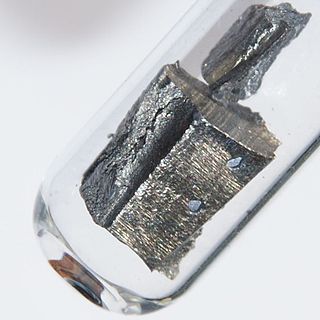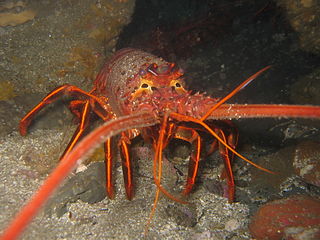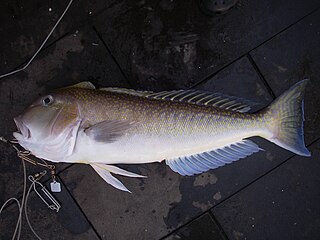Related Research Articles

Neodymium is a chemical element with the symbol Nd and atomic number 60. Neodymium belongs to the lanthanide series and is a rare-earth element. It is a hard, slightly malleable silvery metal that quickly tarnishes in air and moisture. When oxidized, neodymium reacts quickly to produce pink, purple/blue and yellow compounds in the +2, +3 and +4 oxidation states. Neodymium was discovered in 1885 by the Austrian chemist Carl Auer von Welsbach. It is present in significant quantities in the ore minerals monazite and bastnäsite. Neodymium is not found naturally in metallic form or unmixed with other lanthanides, and it is usually refined for general use. Although neodymium is classed as a rare-earth element, it is fairly common, no rarer than cobalt, nickel, or copper, and is widely distributed in the Earth's crust. Most of the world's commercial neodymium is mined in China.

Praseodymium is a chemical element with the symbol Pr and atomic number 59. It is the third member of the lanthanide series and is traditionally considered to be one of the rare-earth metals. Praseodymium is a soft, silvery, malleable and ductile metal, valued for its magnetic, electrical, chemical, and optical properties. It is too reactive to be found in native form, and pure praseodymium metal slowly develops a green oxide coating when exposed to air.

Bycatch, in the fishing industry, is a fish or other marine species that is caught unintentionally while catching certain target species and target sizes of fish, crabs etc. Bycatch is either of a different species, the wrong sex, or is undersized or juvenile individuals of the target species. The term "bycatch" is also sometimes used for untargeted catch in other forms of animal harvesting or collecting. Non-marine species that are caught but regarded as generally 'undesirable' are referred to as rough fish and coarse fish.

The dusky smooth-hound, also called the smooth dogfish or the dog shark, is a species of houndshark in the family Triakidae. This shark is an olive grey or brown in color, and may have shades of yellow or grayish white. Females live to 16 years and males have a lifespan of 10 years. M. canis was the first shark recognised to have viral infections.

The California spiny lobster is a species of spiny lobster found in the eastern Pacific Ocean from Monterey Bay, California, to the Gulf of Tehuantepec, Mexico. It typically grows to a length of 30 cm (12 in) and is a reddish-brown color with stripes along the legs, and has a pair of enlarged antennae but no claws. The interrupted grooves across the tail are characteristic for the species.
A shark repellent is any method of driving sharks away from an area. Shark repellents are a category of animal repellents. Shark repellent technologies include magnetic shark repellent, electropositive shark repellents, electrical repellents, and semiochemicals. Shark repellents can be used to protect people from sharks by driving the sharks away from areas where they are likely to kill human beings. In other applications, they can be used to keep sharks away from areas they may be a danger to themselves due to human activity. In this case, the shark repellent serves as a shark conservation method. There are some naturally-occurring shark repellents; modern artificial shark repellents date to at least the 1940s, with the United States Navy using them in the Pacific Ocean theater of World War II.

The school shark is a houndshark of the family Triakidae, and the only member of the genus Galeorhinus. Common names also include tope shark, snapper shark, and soupfin shark. It is found worldwide in temperate seas at depths down to about 800 m (2,600 ft). It can grow to nearly 2 m long. It feeds both in midwater and near the seabed, and its reproduction is ovoviviparous. This shark is caught in fisheries for its flesh, its fins, and its liver, which has a very high vitamin A content. The IUCN has classified this species as critically endangered in its Red List of Threatened Species.

The dumb gulper shark is a rare and endangered deepwater dogfish, known from only along the east coast of Australia and isolated spots north and west of New Zealand. It is also known as the dumb shark, Harrison's deep-sea dogfish, or Harrison's dogfish.

The gulper shark is a long and slender dogfish usually about three feet in length generally found in deep, murky waters all around the world. It is a light grayish brown, paler ventrally, with a long snout and large greenish eyes. This deep water shark has two dorsal fins with long, grooved spines and the second dorsal fin smaller than the first. Its upper teeth are blade-like and lower have finely serrated edges. This tertiary consumer feeds on mainly fish such as bony fish, but also cephalopods such as squid and other invertebrates like crustaceans. The gulper shark is currently a vulnerable species mainly because of exploitation by humans and their abnormally long gestation period and low fecundity, preventing their population from recovering.

Ocean Guardian is the manufacturer of devices that use Shark Shield Technology. The electrical wave-form used in the Shark Shield Technology is based on a technology originally invented by the KwaZulu-Natal Sharks Board of South Africa in the 1990s.

The black dogfish is a species of dogfish shark in the family Etmopteridae. It is common over the outer continental shelf and continental slope at depths of 180–2,250 m (590–7,380 ft). Females generally inhabit deeper water than males, and depending on the region, smaller sharks may occur at different depths than larger ones. This species is distributed widely in the Atlantic Ocean, from Greenland and Iceland to Virginia and West Africa in the north, and off southwestern Africa and Argentina in the south. The largest member of its family, the black dogfish, typically measures 60–75 cm (24–30 in) long. It has a stocky, dark brown body that is darker below than above, and bears scattered, minute bioluminescent organs. Its two dorsal fins are preceded by stout spines, and the anal fin is absent.

The Portuguese dogfish or Portuguese shark, is a species of sleeper shark of the family Somniosidae. This globally distributed species has been reported down to a depth of 3,675 m (12,057 ft), making it the deepest-living shark known. It inhabits lower continental slopes and abyssal plains, usually staying near the bottom. Stocky and dark brown in color, the Portuguese dogfish can be distinguished from similar-looking species by the small spines in front of its dorsal fins. Its dermal denticles are also unusual, resembling the scales of a bony fish. This species typically reaches 0.9–1 m (3.0–3.3 ft) in length; sharks in the Mediterranean Sea are much smaller and have distinct depth and food preferences.

The largetooth cookiecutter shark is a rare species of squaliform shark in the family Dalatiidae, reported from depths of 60–200 m (200–660 ft) at scattered locations in the Atlantic and Pacific Oceans. As its common name suggests, it is similar in appearance to the cookiecutter shark but has much larger lower teeth. Most individuals also lack the dark "collar" of I. brasiliensis. This species reaches a maximum known length of 42 cm (17 in). The largetooth cookiecutter shark feeds by gouging out chunks of flesh from larger animals, including bony fishes, sharks, and marine mammals, and is able to take larger bites than I. brasiliensis. Little is known of its life history; it is thought to be a weaker swimmer than I. brasiliensis, and is presumably aplacental viviparous like the rest of its family. This shark is an infrequent bycatch of commercial trawl and longline fisheries, but is not thought to be much threatened by these activities.

The smooth lanternshark or slender lanternshark is a species of dogfish shark in the family Etmopteridae, found widely in the Atlantic and Pacific Oceans. It inhabits benthic environments at a depth of 274–1,000 m (899–3,281 ft), and pelagic environments at a depth of 0–708 m (0–2,323 ft). The smooth lanternshark forms a species group with the larger blurred lanternshark, both of which are distinguished from other members of their family by small, irregularly arranged dermal denticles with a truncated shape. This species has a slender, dark brown body with an indistinct black band on the sides over the pelvic fins, and reaches 50 cm (20 in) in length. This slow-growing, ovoviviparous shark feeds on smaller squid, fishes, and fish eggs. Smooth lanternsharks are often caught as bycatch in eastern Atlantic and Japanese commercial fisheries. The International Union for Conservation of Nature (IUCN) has evaluated this species as of Least Concern because of its wide distribution and limited threats.
SharkDefense is a research organization and think tank focused on shark bycatch reduction. Its core research involves chemical and electrochemical shark repellent technologies. SharkDefense's repellent experiments have been featured extensively in the US and European media.
Magnetic shark repellents utilize permanent magnets, which exploit the sensitivity of the Ampullae of Lorenzini in sharks and rays (electrosense). This organ is not found on bony fish (teleosts), therefore, this type of shark repellent is selective to sharks and rays. Permanent magnets do not require power input, making them ideal for use in fisheries and as bycatch reduction devices. Sharkbanz, released in 2014, is a wearable commercially available device intended for recreational users. However independent tests of Sharkbanz products in 2018 highlighted that they did not work.

The fishing industry in the Maldives is the island's second main industry. According to national tradition in the words of former President Maumoon Abdul Gayoom, "Fishing is the lifeblood of our nation, it is inborn. From the soil on which we live, to the sea around us, it remains an integral part of our existence. Fishing, and our country and its people, [are] one and shall remain inseparable forever." The Maldives has an abundance of aquatic life and species of fish. Common are tuna, groupers, dolphin fish, barracuda, rainbow runner, trevally and squirrelfish and many more. Aside from being of essential importance to the economy, fishing is also a popular recreational activity in the Maldives, not only among locals but by tourists. The islands have numerous fishing resorts which cater for these activities.

The great northern tilefish or golden tile, is the largest species in the family Malacanthidae (tilefishes), which grows to an average length between 38 to 44 inches. The great northern tilefish is a slow-growing and long-lived species, which has four stages of life. After hatching from eggs, the larvae are found in plankton. As they grow into juveniles, the individuals seek shelter until finding or making their own burrows. As adults, the tilefish continue to expand their burrows in the sediment throughout their lives. The diet of the larvae is unknown, but presumed to consist of zooplankton; juveniles and adults feed upon various benthic invertebrates, crustaceans, and fish. After reaching sexual maturity between 5 and 7 years of age, females lay eggs throughout the mating season for the male to fertilize, with each female laying an average of 2.3 million eggs.
The Hawaii longline fishery is managed under Western Pacific Regional Fishery Management Council’s (WPRFMC's) Pelagics Fisheries Ecosystem Plan. Through this plan, the WPRFMC has introduced logbooks, observers, vessel monitoring systems, fishing gear modifications and spatial management for the Hawaii longline fishery. Until relatively recently, the main driver for management of the Hawaii longline fishery has been bycatch and not fishery resources.

The Pacific spiny dogfish is a common species of the Squalidae (dogfish) family of sharks and are among the most abundant species of sharks in the world. This species is closely related to Squalus acanthias and for many years they were treated as a single species. Recent research, using meristic, morphological and molecular data led to the resurrection of Pacific Spiny Dogfish as a separate species. The American Fisheries Society recommends the common name "Pacific Spiny Dogfish" for Squalus suckleyi over alternatives such as "Spotted Spiny Dogfish" and "North Pacific Spiny Dogfish" and "Spiny Dogfish" for Squalus acanthias.
References
- ↑ Video of test with electropositive metal
- ↑ AES 2007 Abstract: The Use of Highly Electropositive Metals as Shark Repellents. Eric Stroud, Patrick Rice, Craig O'Connell, Samuel Gruber
- ↑ AES 2008 Abstract: Advances in Shark Repellent Research Using Highly Electropositive Metals. Eric Stroud, Patrick Rice, Craig O'Connell, Samuel Gruber
- ↑ "Reducing elasmobranch bycatch: Laboratory investigation of rare earth metal and magnetic deterrents with spiny dogfish and Pacific halibut". Stoner, Allan W. and Kaimmer, Stephen M. Fisheries Research, 2008.
- ↑ Tallack, M.S.L & J. Mandelman, (in prep). Do rare earth metals deter spiny dogfish? A feasibility study on the use of Mischmetals to reduce dogfish catches in hook and lobster gear in Gulf of Maine.
- ↑ AES 2008 Abstract: The Shifting Baseline of Threshold Feeding Responses to Electropositive Metal Deterrents in Two Species of Dogfish. John Mandelman, Michael Stratton, Michael Tlusty, Shelly Tallack, Tom Fisher, Cheryl Harary, Nils Wernerfelt
- ↑ Favaro, Brett (1 September 2013). "Do by-catch reduction devices in longline fisheries reduce capture of sharks and rays? A global meta-analysis". Fish and Fisheries. 16: 306. Retrieved 23 July 2020.
- ↑ Cardno (October 2015). "Shark Deterrents and Detectors Detectors Review of Bather Protection Review of Bather Protection Technologies Technologies" (PDF). Retrieved 23 July 2020.Cite journal requires
|journal=(help)